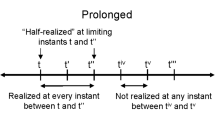Abstract
Time is an enigmatic concept. Although seemingly nowhere to be found and the least tangible of anything, time is the most basic and undeniable aspect of experience. The list of words describing this enigma is comprehensive and often confusing. Therefore, to begin with, I want to clarify my use of the words Time, Temporality, and Now. By Time I do not mean the general concept, but rather a very specific idea: the mathematical-physical concept, linear-successive real-valued time measured by clocks and strongly tied to facticity. Concerning the Now, I do not correlate Now with the present, as is customarily done. Embedded in the paradigm of the Cartesian distinction between res extensa and res cogitans, the extended and the knowing substance, the concepts of Time and Now usually reflect the Cartesian division between matter and mind. In this paradigm, the Now occurs in physical time only as a transition point between earlier-later, past and future, whereas in mental time, the phenomenon of an experienced Now occurs, which is itself transient. In this Cartesian view, the Now belongs to subjective consciousness and has no place in objective physics.
Access this chapter
Tax calculation will be finalised at checkout
Purchases are for personal use only
Preview
Unable to display preview. Download preview PDF.
Similar content being viewed by others
References
Aristoteles (1987): Physik, Bücher I–IV (Meiner, Hamburg).
Atmanspacher H. (1994): Is the ontic/epistemic-distinction sufficient to represent quantum systems exhaustively? In Symposium on the Foundations of Modern Physics 1994, ed. by K.V. Laurikainen, C. Montonen, and K. Sunnarborg (Editions Frontières, Gif-sur-Yvette), 15–32.
Bohr N. (1935): Can quantum mechanical description of physical reality be considered complete? Phys. Rev. 48, 689–702.
Bohr N. (1958): Quantum physics and philosophy, causality and complementarity. In Philosophy in the Mid-Century: A Survey, ed. by R. Klibansky (La Nuova Italia Editrice, Florence), 308–314.
Carnap R. (1963): Autobiography. In The Philosophy of Rudolf Carnap, ed. by P. A. Schilpp (Open Court, La Salle), p. 37.
Derrida J. (1978): Writing and Difference. Routledge and Kegan Paul, London).
Descartes R. (1637/1969): Discours de la méthode pour bien conduire sa raison, et chercher la verité dans les sciences (Von der Methode des richtigen Vernunftgebrauchs und der wissenschaftlichen Forschung) (Meiner, Hamburg).
Eckhorn R., Reitboeck H.J. (1989): Stimulus-specific synchronizations in cat visual cortex and their possible role in visual pattern recognition. In Synergetics of Cognition, ed. by H. Haken, M. Stadler (Springer, Berlin), 99–111.
Eddington A. (1929): Science and the Unseen World (London), p. 11.
Görnitz Th., Ruhnau E., von Weizsäcker C.F. (1991): Temporal asymmetry as precondition of experience — the foundation of the arrow of time. Int. J. Theor. Phys. 31, 37–46.
Gray C.M., Singer W. (1989): Stimulus-specific neuronal oscillations in orientation columns of cat visual cortex. Proc. Natl. Acad. Sci. USA 86, 1698–1702.
Grim P. (1988): Truth, omniscience, and the knower. Phil. Stud. 54, 9–41.
Leibniz G.W. (1714/1956): Monadologie (Meiner, Hamburg).
Newton I. (1687): Philosophiae Naturalis Principia Mathematica(London), translated by A. Cajori (University of California Press, Berkeley 1934).
Omnès R. (1992): Consistent interpretations of quantum mechanics. Rev. Mod. Phys. 64, 339–382.
Paz J.P., Mahler G. (1993): Proposed test for temporal Bell inequalities. Phys. Rev. Lett. 71, 3235–3239.
Pöppel E. (1988): Mindworks: Time and Conscious Experience (Harcourt Brace Jovanovich, New York).
Pöppel E. (1994): Temporal mechanisms in perception. Int. Rev. Neurobiology 37, 123–129.
Pöppel E. (1996): Reconstruction of subjective time on the basis of hierarchically organized processing systems. In Time, Internal Clocks, and Movement, ed by M.A. Pastor, J. Artieda (Elsevier, Amsterdam), 165–185.
Pöppel E., Ruhnau E., Schill K., von Steinbüchel N. (1990): A hypothesis concerning timing in the brain. In Synergetics of Cognition, ed. by H. Haken, M. Stadler (Springer, Berlin), 144–149.
Primas H. (1983): Chemistry, Quantum Mechanics, and Reductionism (Springer, Berlin).
Ruhnau E. (1994): The Now — a hidden window to dynamics. In Inside Versus Outside, ed. by H. Atmanspacher, G.J. Dalenoort (Springer, Berlin), 293–308.
Ruhnau E. (1995): Time Gestalt and the Observer. Reflexions on the tertium datur of consciousness. In Conscious Experience, ed. by T. Metzinger (Imprint Academic, Thorverton), 165–184.
Ruhnau E. (1996): Processes and states. In preparation.
Ruhnau E., Pöppel E. (1991): Adirectional temporal zones in quantum physics and brain physiology. Int. J. Theor. Phys. 30, 1083–1090.
Whitehead A.N. (1929/1978): Process and Reality (Free Press, New York).
Whitehead A.N., Russell B. (1910–1913): Principia Mathematica, Vol. I–III (Cambridge University Press, Cambridge).
Zurek W.H. (1991): Decoherence and the transition from quantum to classical. Physics Today, October, 36–44.
Author information
Authors and Affiliations
Editor information
Editors and Affiliations
Rights and permissions
Copyright information
© 1997 Springer-Verlag Berlin Heidelberg
About this chapter
Cite this chapter
Ruhnau, E. (1997). The Deconstruction of Time and the Emergence of Temporality. In: Atmanspacher, H., Ruhnau, E. (eds) Time, Temporality, Now. Springer, Berlin, Heidelberg. https://doi.org/10.1007/978-3-642-60707-3_5
Download citation
DOI: https://doi.org/10.1007/978-3-642-60707-3_5
Publisher Name: Springer, Berlin, Heidelberg
Print ISBN: 978-3-642-64518-1
Online ISBN: 978-3-642-60707-3
eBook Packages: Springer Book Archive




